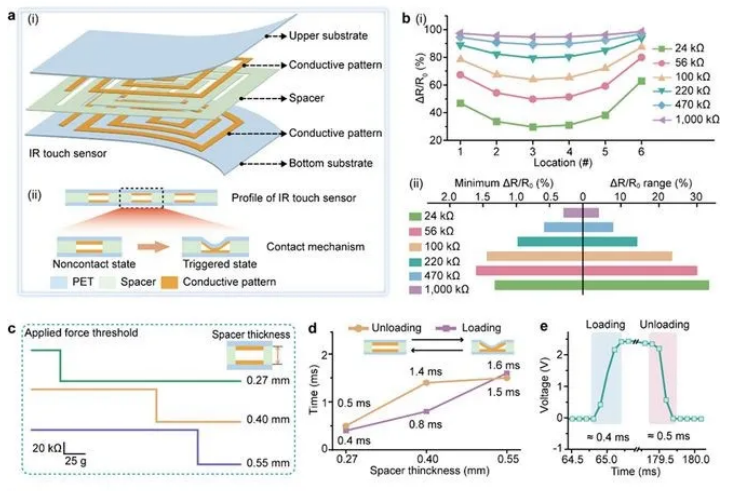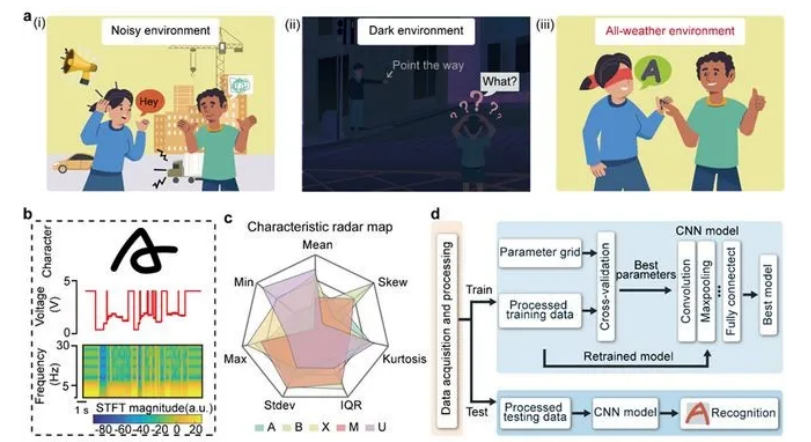The tactile intent recognition system is used to meet human needs or provide humanized services, and should accurately understand and recognize human interaction intentions. Ideally, touch sensors used for intent recognition should be easy to expand and allow for on-demand spatial distribution. However, they typically utilize time driven sensor arrays to achieve high spatiotemporal resolution, which inevitably faces challenges such as low scalability, large data volumes, and complex processing. Ensuring the integrity of intent information while pursuing data simplicity seems to be an irreconcilable paradox.
To address this issue, the team led by Liao Xinqin and Chen Zhong from Xiamen University proposed an event driven intent recognition touch sensor (IR touch sensor), aiming to achieve complex intent recognition through in sensor touch analysis. The IR touch sensor is composed of a biomimetic spiral network, which innovatively combines low dimensional signals and ultra-high precision spatiotemporal resolution into the same device by connecting separated pixel points. This design allows the device to adjust its resolution according to application requirements while maintaining a constant number of electrodes. The characteristics of event driven and sensor based computation effectively eliminate redundant data in the sensing process, enhancing the maintainability and reliability of IR touch sensors in capturing and analyzing touch intent clues. The multifunctional application has demonstrated the integrated functionality of IR touch sensors, which can unleash enormous interactive potential in all-weather environments. This work provides new insights into the use of conscious machine intelligence for tactile intent recognition, which will be widely applied in wearable devices, intelligent robots, medical palpation, and therapy. The study was published in Advanced Functional Materials as a paper titled 'In Sensor Touch Analysis for Intent Recognition'. Professor Chen Zhong and Associate Professor Liao Xinqin from the School of Electronic Science and Technology at Xiamen University are the corresponding authors of the paper. The first author is Xu Yijing, a master's student at Xiamen University. Professor Zheng Yuanjin from Nanyang Technological University in Singapore (Director of the Center for Excellence in Integrated Circuit Design) and Professor Liao Qingliang from Beijing University of Science and Technology (Changjiang Scholar Distinguished Professor and Dean) provide important support and assistance. The research work has received funding from the National Natural Science Foundation of China, the Fuxia Spring National Independent Innovation Demonstration Zone Cooperation Project, the Fujian Provincial Natural Science Foundation, and the Basic Research Funds for Central Universities.

Figure 1 Conceptual diagram for identifying touch sensors
Firstly, the author investigated the pressing performance of IR touch sensors. The results show that the IR touch sensor has a fast response time (<0.5 ms), and there are significant differences in the dynamic response to spatiotemporal mechanical stimuli. Considering the habits of different users, the author also studied the effects of fast touch and long-term touch operations on output signals. At the same time, it was verified that the IR touch sensor has bending insensitivity, ensuring that the IR touch sensor can be attached to curved surfaces and operate stably. The durability of the IR touch sensor was tested through repeated loading unloading tests over 10000 cycles. The response signal shows almost no change, and the IR touch sensor exhibits excellent stability.

Figure 2 Design and Pressing Characteristics of IR Touch Sensor
IR touch sensors can decouple continuous sliding operations, and the author conducted in-depth research on the output characteristics of these sliding operations. By comparing different winding methods, the advantages of the biomimetic spiral mesh structure design were further confirmed, which improved the spatial resolution and uniqueness of the output signal. Thanks to the computing capability within the sensor, the author was able to extract not only the sliding trajectory from the output signal, but also additional motion parameters such as sliding speed.

Figure 3 Sliding performance of IR touch sensor
IR touch sensors also exhibit dual applicability, mainly manifested in two aspects: firstly, they can adapt to different configurations of discrete sensor arrays; Secondly, it can accurately recognize tactile intent under different resolution requirements. These findings are expected to efficiently convey spatial and temporal information, and utilize IR touch sensors to accurately convey the intent of physical touch interactions.

Figure 4 Wide applicability of biomimetic spiral mesh
IR touch sensors, with their ability to perceive different operations, can serve as a multifunctional interface for tactile intent recognition and are used in fields such as gaming, education, healthcare, and smart furniture. By accurately decoding output signals and the wide applicability of sensors, a series of IR touch sensor applications based on different resolutions have been developed (such as controlling PowerPoint presentations, electronic map navigation, and Tetris games), demonstrating the fast response capability and versatility of IR touch sensors.

Figure 5 Typical Applications of Touch Interaction
The tactile intent recognition system can establish correlation between tactile information and human intent without being influenced by environmental factors. Visual and auditory intent recognition systems may be hindered in noisy or visually blurry environments. As a robust alternative, tactile perception stands out due to its effectiveness. Handwriting recognition enables users to input text in the most natural and comfortable way possible. Therefore, tactile intent recognition systems used for handwriting recognition can enhance the overall user experience and accurately convey user ideas.

Figure 6 Machine Learning Assisted Tactile Intent Recognition System
Combining machine learning techniques, the author has developed a machine learning assisted tactile intent recognition system based on IR touch sensors. This system can effectively analyze and interpret complex patterns and features in handwritten input, with an accuracy rate of up to 98.4% for handwritten content recognition. In addition, the system can even capture human unconscious behavior, demonstrating the potential application value of IR touch sensors in diagnosing neurological diseases.
Summary: Overall, the team has developed an intent recognition touch sensor consisting of a biomimetic spiral network with in sensor computing capability and event driven, to achieve concise data output at high resolution while obtaining complete intent information. The event driven method effectively eliminates redundant data in the perception process of time driven sensor arrays. The analysis and computing capabilities within sensors significantly reduce the need for data transmission between sensors and computing terminals. This groundbreaking integration of sensing, data reduction, and ultra-high precision recognition will drive a leapfrog development in the field of intent recognition.
Source: Sensor Expert Network



